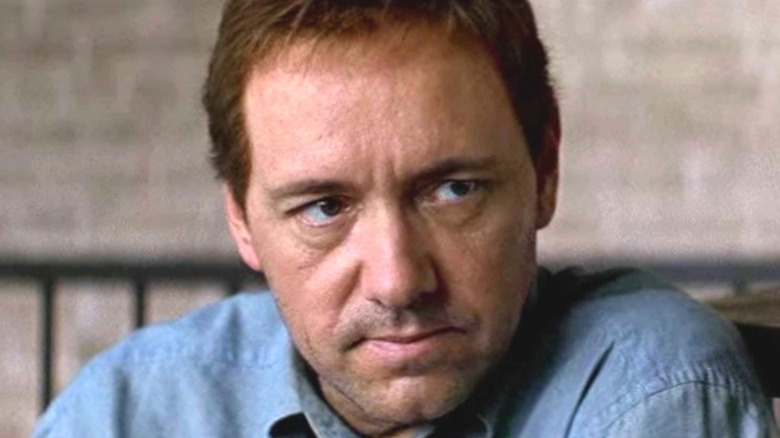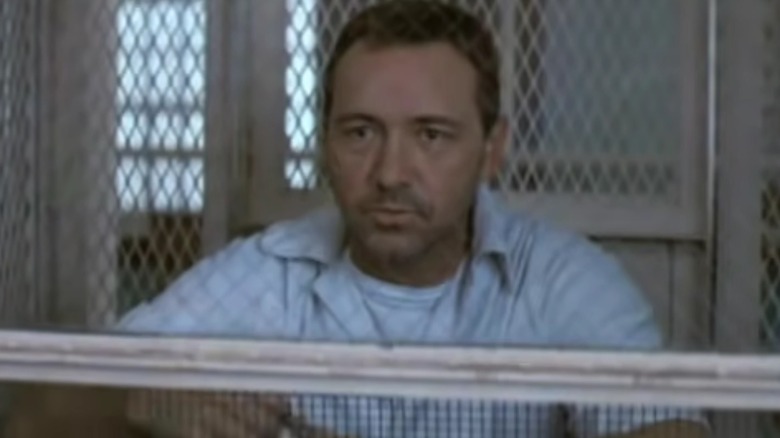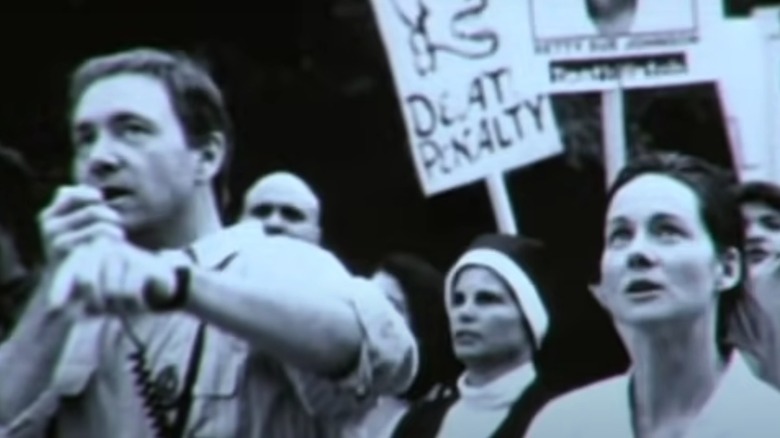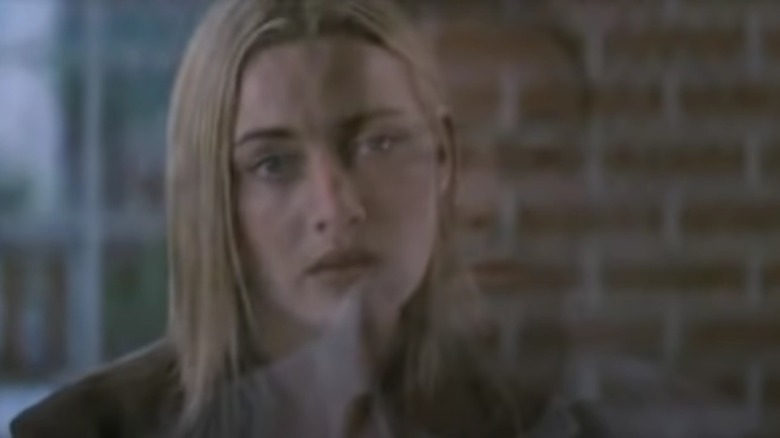The Ending Of The Life Of David Gale Explained
Upon its premiere in 2003, "The Life of David Gale" was met with tepid reviews and was labeled an "implausible, convoluted thriller." However, audiences, in general, don't seem to share the same dim view of the movie as critics do, as evidenced by the wide gulf between the dismal Tomatometer rating of 19% and the considerably higher audience score. Helmed by "Bugsy Malone" and "Mississippi Burning" director Alan Parker, "The Life of David Gale" offers a twisty, turny look at the American capital punishment system.
The film stars Kevin Spacey as David Gale, a philosophy professor and staunch opponent of the death penalty who (irony alert!) is sentenced to death for the rape and murder of fellow activist Constance Harraway, played by Laura Linney. Convinced he is being framed by pro-capital punishment right-wingers, Gale pleads his case to journalist Bitsey Bloom (Kate Winslet) with only three days until his scheduled execution. After a fair amount of flashbacks, sleuthing, and a suspicious man in a cowboy hat, a ripple of third-act revelations finally closes the chapter on "The Life of David Gale." The twist at the film's end proved to be controversial, with Roger Ebert writing, "The last shot made me want to throw something at the screen ..."
Let's unpack it for ourselves and take a closer look at the ending of "The Life of David Gale."
A double twist reveals the truth about Harraway's death
For much of the movie, Gale seems like the obvious culprit in Harraway's murder, as there is ample evidence, including DNA evidence, linking him to the crime. However, as Bloom's investigation continues, what actually happened to Harraway comes into focus.
In between her visits with Gale, Bloom is followed by a mysterious man in a cowboy hat named Dusty Wright (Matt Craven). Bloom begins to suspect that Wright — a former lover of Harraway's and a fellow member of the DeathWatch advocacy group — is actually the murderer. When someone leaves a videotape for Bloom in her motel room, the journalist watches shocking footage of Harraway's asphyxiation and death.
As she struggles to put the pieces together, yet another tape confirms that Harraway, who was suffering from terminal leukemia, actually took her own life and framed it as an elaborate murder, with Wright as her accomplice. Bloom races to reveal this exonerating evidence, but unfortunately, she isn't able to stop Gale's execution. And the twists don't end there. Just when a distraught Bloom thinks she can leave the Gale case behind her, she receives one more tape in the mail labeled "Off the Record." The footage reveals Gale consciously planting his fingerprints on Harraway's body. He then stares into the video camera before shutting it off.
The final reveal confirms that Gale was in cahoots with his DeathWatch colleagues the whole time. Both Harraway and Gale martyred themselves for their beliefs. After Gale's execution, Bloom does release the tape that confirms that Harraway and Wright staged Harraway's "murder." It causes a huge uproar, as the evidence confirms that the state executed an innocent man. Clearly, Harraway and Gale hoped that by sacrificing their own lives in such a fashion, it would help sway public opinion against capital punishment.
If you or anyone you know is having suicidal thoughts, please call the National Suicide Prevention Lifeline at 1-800-273-TALK (8255).
Gale and Harraway plotted to prove their worldview
Although Gale's self-sacrifice seems to come out of the left-field, we do see what very well could have been the inciting moment for this whole plan earlier in the film. In a televised debate with the Governor of Texas, Gale cogently makes the case against the death penalty. While the governor condescendingly paints Gale's arguments as "fuzzy liberal thinking," Gale points to the politician's hypocrisies and asserts that "a flawed system will kill innocent men." However, when asked to name an innocent man who has been executed in Texas, Gale fails to come up with a single name.
In this moment, we can see the idea begin to germinate in Gale's head. In being executed by the state, Gale — an innocent man — will fill the very hole that was missing from his own argument. During the debate, we can also see a visibly invested Harraway on the sidelines. Because she knows that she is already dying from cancer, Harraway seems to have no problem using her death to help advance the abolition of the death penalty.
Gale cherry-picked Bitsy Bloom
With Gale and Harraway's motivations explained, there's another lingering question left by the ending of the film: Why did Gale specifically seek out Bloom to investigate his story? Early in "The Life of David Gale," Bloom is chiefly characterized by her journalistic discretion. During her last assignment, a piece on child pornography, Bloom refused to reveal the source of her article to the authorities, causing her to spend a few days in jail.
Bloom's journalistic integrity explains why Gale sent her the final video implicating himself in the plot. Based on her reputation, he was clearly confident that she wouldn't share the tape with the public, thus protecting the image of his martyred innocence. What's less clear is why he even felt compelled to fill her in. Perhaps it was out of total transparency and a willingness to provide the journalist with some closure. It's also possible that Gale felt a certain amount of hubris, with the tape functioning as his last gasp of "Look what I got away with!" In any case, Bloom seems to function as an analog for the viewer. Whether out of doe-eyed inspiration or moral disgust, the last-minute twist leaves Bloom and the viewers in slack-jawed disbelief.



